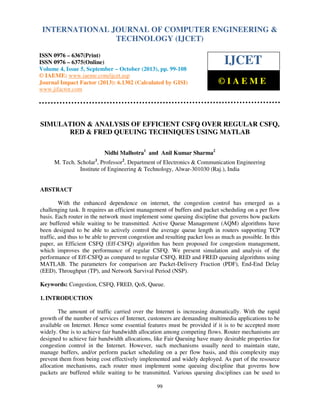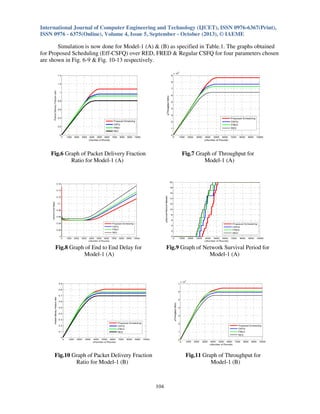This document discusses an efficient CSFQ (Eff-CSFQ) algorithm proposed for congestion management that improves upon regular CSFQ. It summarizes existing queuing techniques like RED, FRED, and CSFQ that are used to control packet transmission and dropping. The proposed Eff-CSFQ combines priority queuing and max-min fairness with CSFQ, treating real-time traffic like VoIP as higher priority and using multiple queues for such flows at core routers. This improves fairness and avoids congestion compared to the single FIFO queue used in regular CSFQ. The document aims to simulate and analyze the performance of Eff-CSFQ versus regular CSFQ, RED and FRED using metrics like packet delivery fraction, end-to

![International Journal of Computer Engineering and Technology (IJCET), ISSN 0976-6367(Print),
ISSN 0976 - 6375(Online), Volume 4, Issue 5, September - October (2013), © IAEME
control which packets get transmitted (bandwidth allocation) and which packets get dropped (buffer
space).The queuing discipline also affects the latency experienced by a packet, by determining how
long a packet waits to be transmitted. A scheduling discipline should support the fair distribution of
bandwidth to each of the service classes competing for bandwidth on the output port and furnish
protection (firewalls) between different service classes on an output port so that a poor service class
queue cannot impact in bandwidth & delay delivered to other service classes assigned to other
queues on the same port. It should allow other service classes to access bandwidth that is assigned to
a given service class and also provide an algorithm that can be implemented in hardware, so it can
arbitrate access to bandwidth on the higher-speed router interfaces without negatively impacting
system forwarding performance. In order to complete various processes successfully, the network
should maintain a good Quality of Service (QoS) to provide satisfactory results to the user. When
specifying the QoS, a number of factors are taken into account like latency, jitter, packet loss and
throughput. Quantifying the above parameters allows us to find out how efficiently the traffic in an
IP network is being managed and whether the network is suitable for the data we wish to transmit or
not. Different kinds of applications have different requirements for the parameters listed above [1].
2. EXISTING QUEUING TECHNIQUES
Various queuing disciplines are used to control which packets get transmitted and which
packets get dropped. The more popular queuing disciplines are Random Early Drop (RED), Flow
Random Early Drop (FRED) and Core Stateless Fair Queuing (CSFQ). The RED is to detect
incipient congestion early and to convey congestion notification to the end-hosts, allowing them to
reduce their transmission rates before queues in the network overflow and packets are dropped. It
keeps no per flow state information. Packets are dropped probabilistically based on the long-term
average queue size and fixed indicators of congestion (thresholds). It uses randomization to drop
arriving packets to avoid biases against bursty traffic and roughly drops packets in proportion to the
flows data rate at the router. FRED is a modified version of RED, which uses per-active-flow
accounting to make different dropping decisions for connections with different bandwidth usages. It
only keeps track of flows that have packets in the buffer, thus the cost of FRED is proportional to the
buffer size and independent of the total flow numbers including the short-lived and idle flows. FRED
uses per-flow preferential dropping to achieve fairer allocation of bandwidth among flows and builds
per-flow state at the router by examining those packets that are currently in the queue [2]. In typical
deployment, edge routers might handle thousands of flows, while core routers might handle 50k100k flows. It exploits this gap by delegating the management of per-flow statistics to the edge
routers. Edge routers then share this information with core routers by labeling each packet that they
forward. Core routers, in turn, can use the labels to allocate bandwidth fairly among all incoming
flows. In case of CSFQ, edge routers run essentially the same algorithm as core routers, however,
edge routers have the added responsibility of maintaining per-flow state [3]. The CSFQ technique
has some important features. First is dynamic packet state in which Edge routers label each packet
with an estimate of the arrival rate for each flow. Per-flow statistics are maintained here. Secondly
the Core routers use estimated arrival rates provided on packet labels, and an internal measure of
fair-share, to compute the probability of dropping each incoming Packet. Every packet that is
accepted is processed and relabeled with new arrival rate information. Lastly the estimation
procedure for the “fair-share” value convergences rapidly to the optimal value. Cheaters cannot win
too much extra bandwidth. There are two goals for a CSFQ router. First is to maintain max-min
fairness for bandwidth allocation and second is to avoid having to keep per-flow statistics in highspeed core routers. The second goal prevents a core router from maintaining per-flow queues.
Therefore, once a packet has been accepted by a core router, it sits in one of a small number of
queues until it is eventually processed. Hence, the only action the core router can take in order to
100](https://image.slidesharecdn.com/50120130405013-131024061312-phpapp02/85/50120130405013-2-320.jpg)






![International Journal of Computer Engineering and Technology (IJCET), ISSN 0976-6367(Print),
ISSN 0976 - 6375(Online), Volume 4, Issue 5, September - October (2013), © IAEME
0.25
Proposed Scheduling
CSFQ
FRED
RED
y(End to End Delay)
0.2
0.15
0.1
0.05
0
0
5
10
15
20
25
30
x(Number of Rounds)
35
40
45
50
Fig.20 Graph of End to End Delay for Model-3 (A)
5. CONCLUSION
In this work a new queue management technique i.e. Eff-CSFQ has been proposed and
simulated using MATLAB. After analyzing on the basis of graphs of simulation results obtained and
studying Table. 2 & 3, it has been found that the performance of Eff-CSFQ is much better and
superior to regular CSFQ and far better than RED, FRED Queuing algorithms for all the parameters
chosen (i.e. Throughput, Packet Delivery Fraction, End to End Delay and Network survival Period),
even if the field area or the number of devices are varied. This is also evident in Fig. 18-20 even if
the pause time is varied.
REFERENCES
[1]
[2]
[3]
[4]
[5]
[6]
[7]
[8]
[9]
H.Gundersen and F.T. Grimstad , “QoS for Real Time Traffic” IEEE computer and
Communication proceedings, New York, pp. 50-55,2001
Dong Lin, Robert Morris, “Dynamics of Random Early Detection”, ACM SIGCOMM
Computer Communication Review, Vol. 27, Issue-4, Pages 127 - 137, 1997..
Ion Stoica , Scott Shenker , Hui Zhang “CSFQ : Achieving Approximately Fair Bandwidth
Allocations in High Speed Networks” IEEE/ACM transactions on Networking, Vancouver,
pp 33-46,2003.
Masayoshi Nabeshima “Adaptive CSFQ: determining the packet dropping probability
adaptively for achieving fair bandwidth allocations in SCORE networks” conference on
computer communications, Yokosuka-shi, Kanagawa, Japan , pp. 1-2,2002
Velmurugan, T., Chandra, H., Balaji, S., “Comparison of Queuing Disciplines for
Differentiated Services Using OPNET”, IEEE, International Conference on Advances in
Recent Technologies in Communication and Computing, ISBN:978-1-4244-5104-3, pp. 744746, 2009.
Addisu Eshete, Yuming Jiang, “Approximate Fairness through Limited Flow List”, IEEE,
23rd International Teletraffic Congress (ITC), ISBN 978-1-4577-1187-9, pp. 198 – 205,
2011.
C.Semeria “Supporting differentiated service classes, queue scheduling disciplines” white
paper, pp 5-25. www.juniper.net,2001.
M. Gospodinov, “The affects of different queuing disciplines over FTP, Video and VoIP
Performance”, International conference on Computer Systems and Technologies,
CompSysTech, pp 1-5, 2004.
T.Subash and S.Indira Gandhi “Performance Analysis of Scheduling Disciplines in Optical
Networks” , IEEE Published, pp 1-5,2006.
107](https://image.slidesharecdn.com/50120130405013-131024061312-phpapp02/85/50120130405013-9-320.jpg)
![International Journal of Computer Engineering and Technology (IJCET), ISSN 0976-6367(Print),
ISSN 0976 - 6375(Online), Volume 4, Issue 5, September - October (2013), © IAEME
[10] N. Sulaiman, R.Carrasco and G. Chester “Analyzing the Performance of Voice over Internet
Protocol in a 3G Network”, IEEE Published, pp 1-5,2006.
[11] L.Le, K. Jeffay and F.D Smith “A Loss and Queuing-Delay Controller for Router Buffer
Management”, IEEE, pp 1-10,2006.
[12] Prof. J. R. Pathan, Prof. A. R. Teke, Prof. M. A. Parjane and Prof. P.S. Togrikar, “Dropping
Based Contention Resolution for Service Differentiation to Provide QoS in Wdm OBS
Networks”, International Journal of Computer Engineering & Technology (IJCET),
Volume 4, Issue 1, 2013, pp. 218 - 228, ISSN Print: 0976 – 6367, ISSN Online: 0976 – 6375.
[13] V. Bapuji, R. Naveen Kumar, Dr. A. Govardhan and Prof. S.S.V.N. Sarma, “Maximizing
Lifespan of Mobile Ad Hoc Networks with QoS Provision Routing Protocol”, International
Journal of Computer Engineering & Technology (IJCET), Volume 3, Issue 2, 2012,
pp. 150 - 156, ISSN Print: 0976 – 6367, ISSN Online: 0976 – 6375.
[14] Sharada Kesarkar and Prof. Prabha Kasliwal, “FPGA Implementation of Scalable Queue
Manager”, International Journal of Electronics and Communication Engineering &
Technology (IJECET), Volume 4, Issue 1, 2013, pp. 79 - 84, ISSN Print: 0976- 6464,
ISSN Online: 0976 –6472.
[15] Jayashree Agrakhed, G. S. Biradar and V. D. Mytri, “Optimal QoS Routing with Prioritized
Region Scheduling Over WMSN”, International Journal of Computer Engineering &
Technology (IJCET), Volume 3, Issue 1, 2012, pp. 289 - 304, ISSN Print: 0976 – 6367,
ISSN Online: 0976 – 6375.
[16] Dr.K.Prasadh and R.Senthilkumar, “Nonhomogeneous Network Traffic Control System using
Queueing Theory”, International Journal of Computer Engineering & Technology (IJCET),
Volume 3, Issue 3, 2012, pp. 394 - 405, ISSN Print: 0976 – 6367, ISSN Online: 0976 – 6375.
108](https://image.slidesharecdn.com/50120130405013-131024061312-phpapp02/85/50120130405013-10-320.jpg)